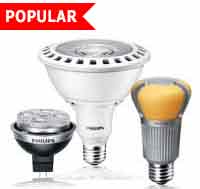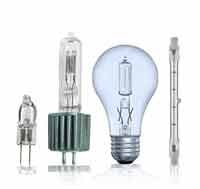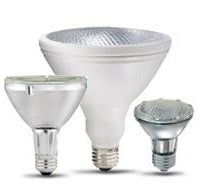HID Bulbs: More Than Just a Bright Idea
HID bulbs generate light by discharging electricity from a filament into a gas filled envelope, thus producing light. There are several types of HID bulbs including metal halide bulbs, low/high pressure sodium vapor bulbs, mercury vapor, xenon short arc bulbs, and others. HID bulbs have a high degree of luminous efficacy (a high proportion of luminous flux to wattage) and therefore produce a significant amount of visible light and little heat.HID lights produce so much light in fact, that it is no surprise that they are the bulb of choice for growing plants in indoor gardens.
Metal halide bulbs are particularly popular. With a lifespan of 15,000-20,000+ hours, (nearly 20X the lifespan of an incandescent bulb) and 65-115 lumens per watt the metal halide bulb is among the most efficient. What makes metal halide bulbs the most versatile of the HID bulbs is their 65-90 color rendering index (CRI) score, bringing the metal halide close to the 100 CRI rating of sunlight and close to ‘true’ color. High pressure sodium bulbs, for example, have a CRI score of 20-25, casting whatever the bulb illuminates in a yellow glow. This severely limits the applications of high pressure sodium bulbs. Because metal halides are close to a CRI of 100, they can be used in areas where accurate color is important like inside a kitchen or supermarket. For a bulb that can fill a large place with lots of light efficiently, the HID bulb is a great choice. The luminosity and true color also make the metal halide bulb a popular choice in film and photography where light and color must be rendered accurately. The different types of HID bulbs and the types of fixtures to which they are configured make it a versatile and economic option.
HIDs are versatile and efficient: use them in your kitchen, parking lot, movie set, or greenhouse and you will find that your lighting and energy needs are met.
Metal halide bulbs are particularly popular. With a lifespan of 15,000-20,000+ hours, (nearly 20X the lifespan of an incandescent bulb) and 65-115 lumens per watt the metal halide bulb is among the most efficient. What makes metal halide bulbs the most versatile of the HID bulbs is their 65-90 color rendering index (CRI) score, bringing the metal halide close to the 100 CRI rating of sunlight and close to ‘true’ color. High pressure sodium bulbs, for example, have a CRI score of 20-25, casting whatever the bulb illuminates in a yellow glow. This severely limits the applications of high pressure sodium bulbs. Because metal halides are close to a CRI of 100, they can be used in areas where accurate color is important like inside a kitchen or supermarket. For a bulb that can fill a large place with lots of light efficiently, the HID bulb is a great choice. The luminosity and true color also make the metal halide bulb a popular choice in film and photography where light and color must be rendered accurately. The different types of HID bulbs and the types of fixtures to which they are configured make it a versatile and economic option.
HIDs are versatile and efficient: use them in your kitchen, parking lot, movie set, or greenhouse and you will find that your lighting and energy needs are met.






 A Purdue University land-use scientist found in 2007 that there are likely more parking spaces in the United States than cars. The scientist found that parking lots in Illinois, Indiana, Michigan, and Wisconsin amounted to about 490 square miles. Parking lots pose numerous environmental problems. One of the most important is how to light these often large lots efficiently for hours on end every day of the year. Fortunately, there seems to be an environmentally friendly solution:
A Purdue University land-use scientist found in 2007 that there are likely more parking spaces in the United States than cars. The scientist found that parking lots in Illinois, Indiana, Michigan, and Wisconsin amounted to about 490 square miles. Parking lots pose numerous environmental problems. One of the most important is how to light these often large lots efficiently for hours on end every day of the year. Fortunately, there seems to be an environmentally friendly solution:





Comments